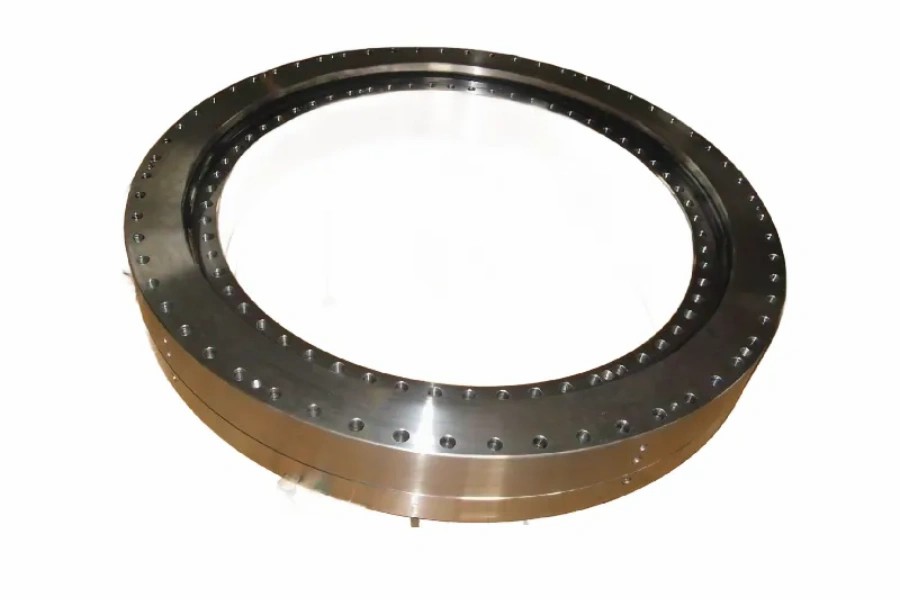
What is a Single Row Cross Roller Slewing Bearing?
What is a Single Row Cross Roller Slewing Bearing?
A Single Row Cross Roller Slewing Bearing is a specialized type of rotary bearing designed to handle axial, radial, and moment (tilting) loads simultaneously. Unlike standard bearings, it uses cylindrical or tapered rollers arranged in a cross pattern (90° to each other) within a single row. This unique design maximizes load distribution and rigidity, making it ideal for applications requiring high precision and compactness. Think of it as the “Swiss Army knife” of bearings – it simplifies complex mechanical systems by replacing multiple bearing setups with a single unit.
Types of Single Row Cross Roller Slewing Bearings
Standard Cross Roller:
Basic design with cylindrical rollers in a cross arrangement.
Used in general industrial applications.
Tapered Cross Roller:
Uses tapered rollers for higher load capacity and better alignment.
Common in heavy machinery like cranes.
Gear-Integrated Types:
Features internal or external gear teeth for direct drive integration.
Found in robotics or solar trackers.
Flange-Mounted:
Includes mounting flanges for easy installation.
Popular in medical imaging devices.
Sealed vs. Open:
Sealed types have rubber or metal shields to block dust/water.
Open types allow for custom lubrication but require more maintenance.
Key Features of Single Row Cross Roller Slewing Bearings
High Load Capacity: Handles all-directional loads in a single row.
Compact Design: Saves space by combining axial/radial support into one unit.
Precision: Low rotational resistance and minimal deflection for accurate positioning (e.g., robotic arms).
Durability: Hardened steel rollers and raceways resist wear.
Lightweight: Aluminum alloy options available for weight-sensitive applications (e.g., drones).
Customizable: Options for gear teeth, seals, lubrication ports, and mounting holes.
Applications of Single Row Cross Roller Slewing Bearings
Industrial Robots: Provides precise rotation for robotic joints.
Medical Equipment: MRI machines, CT scanners, and surgical robots.
Solar Trackers: Rotates solar panels to follow the sun.
Machine Tools: Rotary tables for CNC machining.
Aerospace: Satellite antennas and drone gimbals.
Construction Equipment: Compact cranes and excavators.
Price Range
Prices vary based on:
Size: Small bearings (e.g., 100mm diameter) start at ~
200.Largeindustrialunits(1,500mm+)canexceed10,000.
Material: Stainless steel costs 20–30% more than carbon steel.
Precision Grade: High-precision bearings (for medical/optical use) cost 2–3x more than standard versions.
Customization: Adding gears, special seals, or coatings increases price by 15–50%.
Brand: Japanese/German brands (IKO, Schaeffler) are premium; Chinese suppliers offer budget options.
Example: A medium-sized (500mm) standard cross roller bearing costs
1,500–3,000.
Lifespan of Single Row Cross Roller Slewing Bearing
Typical lifespan depends on:
Load Conditions: Overloading shortens life. Stick to 70–80% of the rated load for longevity.
Lubrication: Regular greasing (every 6–12 months) prevents wear.
Environment: Harsh conditions (e.g., saltwater, metal dust) cut lifespan by 30–50%.
Installation: Poor alignment causes uneven roller stress.
Average Lifespan:
Industrial robots: 8–12 years.
Medical devices: 10–15 years (light use, clean environments).
Construction equipment: 5–8 years (heavy loads, dusty sites).
Custom Specialists: Suppliers offering tailored designs (gears, seals, materials).
Regional Distributors: Local suppliers reduce shipping costs and lead times.
Online Marketplaces: Platforms like Alibaba or ThomasNet for comparing options.
Red Flags:
No load-test reports or warranties.
Vague material certifications (e.g., “high-quality steel” without specs).
How to Choose the Right Single Row Cross Roller Slewing Bearing
Follow this guide to avoid costly mistakes:
Calculate Your Loads
Axial Load: Vertical force (e.g., weight pressing down on a turntable).
Radial Load: Horizontal force (e.g., a robotic arm extending sideways).
Moment Load: Tilting force (e.g., off-center weight on a rotating platform).
Pro Tip: Use a safety factor of 1.5x your max calculated load.
Define Precision Needs
Backlash: Near-zero backlash is critical for robotics or optical systems.
Runout: Low runout (≤0.01mm) ensures smooth rotation in precision tools.
Assess Environmental Factors
Sealing: IP65+ seals for wet/dirty environments (e.g., construction sites).
Temperature: Standard bearings work at -30°C to +120°C. Extreme temps require special grease.
Corrosion: Stainless steel or coatings for marine/chemical exposure.
Choose the Right Type
Gear-Integrated: For direct motor/drive coupling (saves space).
Tapered Rollers: If shock loads are common (e.g., mining equipment).
Lightweight Alloy: For drones or portable devices.
Check Mounting Requirements
Hole Patterns: Match bolt holes to your machine’s baseplate.
Shaft Compatibility: Ensure inner/outer diameters fit existing shafts.
Flange vs. Standard: Flanges simplify installation but add weight.
Lubrication & Maintenance
Grease Type: High-speed applications need low-viscosity grease.
Service Access: Can you easily reach the bearing for re-greasing?
Sealed vs. Open: Sealed bearings reduce maintenance but limit customization.
Budget vs. Quality
Cheap Options: Risk premature failure – okay for non-critical uses.
Mid-Range: Balance cost and reliability for most industrial apps.
High-End: Necessary for aerospace/medical where failure isn’t an option.
Verify Certifications
Material Certificates: Confirm steel grade (e.g., SAE 52100 for bearings).
Load Test Reports: Ask for proof of dynamic/static load ratings.
Industry Standards: CE, RoHS, or ISO certifications for quality assurance.
Test Before Mass Purchase
Order a sample to check fit, noise, and heat generation under load.
Run accelerated life tests if possible (e.g., 24/7 operation for a week).
Plan for Replacement
Check lead times – custom bearings can take months to produce.
Keep spares if downtime is costly (e.g., production lines).
Common Mistakes to Avoid
Ignoring Moment Loads: Even small off-center weights can wreck the bearing.
Wrong Lubricant: Using generic grease instead of high-temperature/water-resistant types.
Over-Tightening Bolts: Distorts the raceway, causing uneven roller wear.
Mismatched Materials: Pairing a stainless steel bearing with a carbon steel frame risks galvanic corrosion.
Single Row Cross Roller Slewing Bearing Supplier
LYRA Drive is a professional slewing bearings ,slew drive, slewdrives and gears manufacturer provides customizedslew bearing, drive and gears.For application-specific engineering solutions, contact LYRA to discuss technical specifications and implementation strategies.